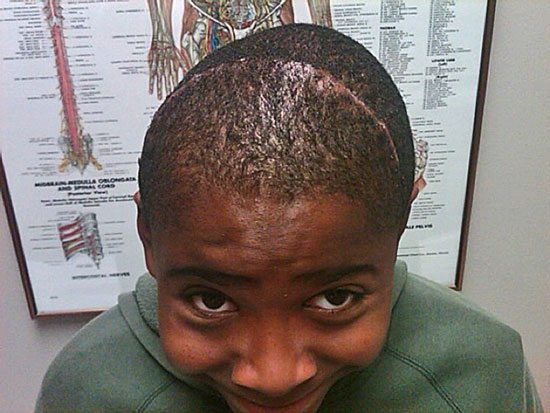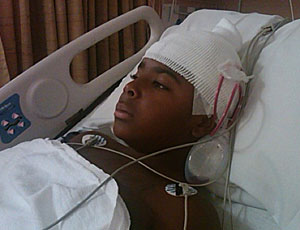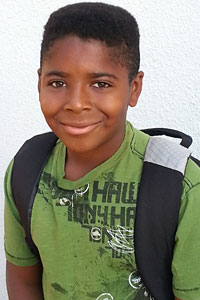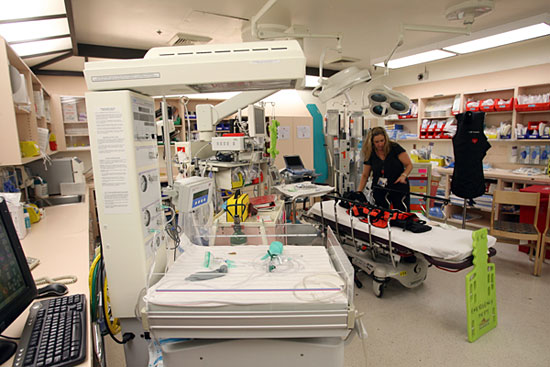Making kids’ trauma less traumatic
September 11, 2012

Jordan made a full recovery from the head injury for which he was treated at the pediatric trauma center.
JoAnn Hanson-Nortey got the awful phone call a year ago this week: Her 10-year-old son, Jordan, running full-tilt on the playground, had collided with another child and suffered a severe head injury.
“It was a freak thing,” recalls the Sherman Oaks mother. “They had banged heads running around a wall. You wouldn’t think it would be that serious, but it caused a skull fracture—the neurosurgeon said it was like a crack in an eggshell.” Had he not received immediate treatment, he could have suffered permanent brain damage or worse.
Instead, emergency medical technicians swiftly transported both Jordan and the other child, who also was seriously injured, to Northridge Hospital’s Richie Pediatric Trauma Center, which celebrates its second anniversary on October 4.
Championed by Los Angeles City Councilman Richard Alarcon with crucial assists from Supervisor Zev Yaroslavsky, state Sen. Alex Padilla (D-Pacoima) and others, the center is one of only seven such units in Los Angeles County. It is also the first and only one to serve the San Fernando Valley’s littlest trauma patients, who until the center’s 2010 opening had to be airlifted to UCLA’s pediatric trauma center or to Children’s Hospital in Hollywood.
“We have saved some real lives,” says Northridge Hospital’s interim president, Saliba Salo, noting that the so-called “golden hour”—the 60-minute window right after an injury in which quick treatment can make a life-or-death difference—is doubly important for children. Indeed, pediatric patients are so much more fragile that doctors refer to their window as the “platinum half-hour.”
“In the fiscal year before we opened the unit, we saw only eleven kids under age 14 for trauma,” says Salo. “But in fiscal year 2011, we saw 151, and we anticipate 155 this year.”
The center has been a longtime goal for the Valley, where doctors, first responders and community leaders advocated for years for its opening. Alarcon, in fact, made it a personal crusade after his 3-year-old son, Richie, was gravely injured in a 1987 car crash on Victory Boulevard; a suicidal driver rammed into the car in which the baby was riding, and because there was no pediatric trauma unit nearby, the little boy’s treatment was delayed while he was airlifted to Children’s Hospital Los Angeles, where he died the next day.
In 2005, Alarcon—who by then was in the state senate—introduced a bill to authorize California counties to levy a surcharge on traffic tickets, a portion of which would fund pediatric trauma centers. The bill was vetoed, but Alarcon introduced it again in 2006.
This time it passed, and when it was scheduled to expire three years later, Padilla authored an extension. Los Angeles County Supervisors, meanwhile, agreed to levy the fine here, and to tap the so-called “Richie’s Fund” revenue to help launch the unit. Although private donations to the hospital remain crucial, the county’s funding distribution to its trauma and emergency care network has since included $1.6 million in startup operating funds for the center in 2011 and $1.74 million this year.
County health officials report that the Northridge unit not only hastens care for the Valley’s trauma victims, but also shortens wait times at the county’s other trauma care units by lightening the patient load elsewhere. Before Northridge Hospital was certified as a pediatric trauma center, every young trauma patient in the Valley or even points north of the county line had to be transported long distances to receive care, usually to Children’s Hospital in Hollywood or to UCLA. This year, nearly 42% of them have remained in the Valley for treatment.
The unit this year treated children from 47 cities and from as far away as Sacramento County, though the bulk of its patients come from the Valley. That proximity is key because having family members at hand plays a big part in a child’s recovery, says Melanie Crowley, who manages the hospital’s trauma program.
“If you or I had a child transported to UCLA or Children’s, we might wonder which car we were going to take to the hospital to see them,” says Crowley. “But a lot of our families don’t even have cars. They have to decide which bus to take.”
Crowley says the center’s cases run the gamut. “But the ones that stick in my mind are the ones that happen just because of the normal things that kids do. Kids who were just jumping on the couch when they fell and got a bleed on the brain. Kids who chased a ball out onto the street and got hit by a car. Kids injured because a car seat was installed improperly.”
And kids like Jordan, who, because the Richie Center existed, was getting a CT scan in preparation for neurosurgery within 45 minutes of his accident.
“The doctor literally called me from his car on the way to the hospital to explain the operation,” recalls Hanson-Nortey, a single mother who remained at her son’s bedside, 24-7, for the next five days. After some physical therapy, he was home, and 3 months later, Jordan was back to school full-time.
“I probably could have gone back in like a month,” the now-11-year-old boy says, “but my mom wanted to be safe.”
Since then, his scars have healed, his hair has grown back and he plays tennis and begs his mother to let him play football—in vain. She says she has seen a side of her son that is braver than she had ever imagined; he says he’d like to be a policeman someday.
“I wasn’t that scared because I knew the doctors were going to make me better,” he says now. His mother’s perspective is slightly different.
“The people at the hospital turned something really awful into something that was just pretty bad that we could get over,” she says.
Posted 9/11/12















 405 bridge work causes a stink
405 bridge work causes a stink
